Don't wanna be here? Send us removal request.
Text
Coffeeholic Logo — Color Based

Source: The CoffeeHolic.



Source: Cofeeholicsva.

Source: Coffeeholic/Facebook.

Source: Coffeeholic.nab/Instagram.

Coffee Shop Logo. Source: Deputera/Puteradesign/Pinterest.

Source: Coffeeholic Cafe/Bistro/Trip Advisor.

Source: Coffeeholic/Facebook.

Source: Coffeeholic Cafe.

Source: Coffee' Holic/Facebook.
0 notes
Text
Coffeeholic Logo – White Base

Source: coffeeholickrw/Instagram.

Source: Coffeeholicbrand.

Source: The Lakes Entertainment Center.

Source: Dreamstime.


Coffeeholic. Source: Yoshiyuki Yagi/Dribble.

Source: Pikbest.

Source: Cafetaria CoffeeHolic/Facebook.

Source: The Coffeeholic/Facebook.

Source: Coffeeholic/Facebook.

Source: exprez.

Source: Coffeeholic House/Craverapp.

Source: Coffeeholic VietNam/Facebook.

Source: janatulferdaus64/Freelancer.


Coffee Coffeeholic Design Art Print. Source: Klein Jenny/Redbubble.

Source: Ciao Rolling News.

Source: The Coffeeholics/Facebook.

Source: iFood.



Source: Tobias Saul.

Source: Friendchised.
0 notes
Text
Black Holes – Devouring Stars

Astronomers have observed material being blown away from a black hole after it tore a star apart. This event, known as a “tidal disruption,” is depicted in the artist’s illustration. Source: NASA/CXC/U. Michigan/J. Miller et al.; Illustration: NASA/CXC/M. Weiss.

This illustration shows a glowing stream of material from a star disrupted as it was being devoured by a supermassive black hole. The black hole is surrounded by a ring of dust. When a star passes close enough to be swallowed by a black hole, the stellar material is stretched and compressed as it is pulled in, releasing an enormous amount of energy. Source: NASA/JPL-Caltech.

This artist’s impression depicts a star being torn apart by an intermediate-mass black hole (IMBH), surrounded by an accretion disc. This thin, rotating disc of material consists of the leftovers of a star that was ripped apart by the tidal forces of the black hole. Source: ESA/Hubble, M. Kornmesser.

Illustration of black hole destroying a planet. Source: Getty.

The gravitational pull of even a small black hole is immense. Source: © Lola Post Productions/BBCEarth.

NASA’s Chandra X-ray observatory detected record-breaking wind speeds coming from a disk around a black hole. This artist's impression shows how the strong gravity of the black hole, on the left, is pulling gas away from a companion star on the right. This gas forms a disk of hot gas around the black hole, and the wind is driven off this disk at 20 million mph, or about 3% the speed of light. - More info. Source: NASA/CXC/M.Weiss.

A black hole is so dense that it warps the spacetime that surrounds it. Source: © Lola Post Productions/BBCEarth.

Artist's concept of a cracked neutron star orbiting a black hole. Credit: Caltech/R. Hurt (IPAC).

Sagittarius A* has the power to tear apart any planet that strays too close. Source: © Lola Post Productions/BBCEarth.
0 notes
Text
Black Holes – Accretion Disk

A stock illustation of a black hole. Credit: Getty.

Source: Earth.com.

An illustration of a black hole surrounded by an accretion disk feeding it. Credit: ESO, ESA/Hubble, M. Kornmesser.

Source: Carnegie Science.

An artist's rendering of a black hole. Credit: Mark Garlick/Science Photo Library via Getty Images.

This artist’s concept portrays the supermassive black hole at the center of the Milky Way galaxy, known as Sagittarius A* (A-star). It’s surrounded by a swirling accretion disk of hot gas. The black hole’s gravity bends light from the far side of the disk, making it appear to wrap above and below the black hole. Several flaring hot spots that resemble solar flares, but on a more energetic scale, are seen in the disk. NASA’s James Webb Space Telescope has detected both bright flares and fainter flickers coming from Sagittarius A*. The flickers are so rapid they must originate very close to the black hole. Source: NASA, ESA, CSA, Ralf Crawford (STScI)/NASA Science.

This artist’s impression illustrates the mechanism that could be at the origin of the powerful bursts of X-ray light seen from a newly awakened black hole named Ansky. Credit: European Space Agency (ESA).

Sagittarius A* is a supermassive black hole at the heart of the Milky Way. Source: © Lola Post Productions/BBCEarth.
0 notes
Text
Black Holes – Binary

Two black holes spiral towards each other in an inescapable dance. Source: © Lola Post Productions/BBCEarth.

This artistic illustration is of a binary black hole found in the center of the nearest quasar to Earth, Markarian 231. Credit: NASA, ESA, and G. Bacon (STScI).
0 notes
Text
Black Holes – Singular

Scientists obtained the first image of a black hole, seen here, using Event Horizon Telescope observations of the center of the galaxy M87. The image shows a bright ring formed as light bends due to the intense gravity around a black hole that is 6.5 billion times more massive than our Sun. Source: Event Horizon Telescope Collaboration.

Credit: EHT Collaboration.

The James Webb Space Telescope’s CEERS Survey has uncovered the most distant active supermassive black hole ever found, existing just over 570 million years after the Big Bang. It also discovered two more small black holes and nearly a dozen extremely distant galaxies. These findings challenge previous assumptions about the prevalence of less massive black holes and galaxies in the early universe. Source: Space Telescope Science Institute.

Credit: Robert Lea (created with Canva).

Almost every galaxy has a supermassive black hole at its center, like the one in this illustration. But sometimes those black holes get knocked around or kicked out of their galaxies entirely. Source: NASA’s Goddard Space Flight Center, DPAC/Gaia/ESA.

3D renderring of a aupermassive black hole, in the foreground against a galaxy and starry sky. Source: vitacop/Alamy Stock Photo.

In this illustration of a black hole and its surrounding disk, gas spiraling toward the black hole piles up just outside it, creating a traffic jam. The traffic jam is closer in for smaller black holes, so X-rays are emitted on a shorter timescale. Source: NASA.

Black holes are forged from the small, dense, remnant cores of dead stars. Source: © Lola Post Productions/BBCEarth.
0 notes
Text
Black Holes – Stellar Jewelry Box
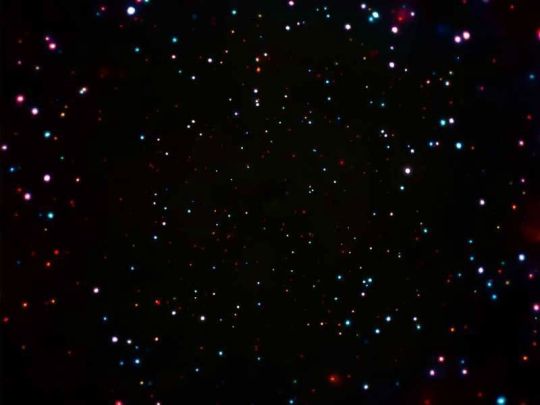
The central region of this image contains the highest concentration of supermassive black holes ever seen and about a billion over the entire sky. Made with over 7 million seconds of Chandra observing time, this 2017 image is part of the Chandra Deep Field-South. With its unprecedented look at the early universe in X-rays, it offers astronomers a look at the growth of black holes over billions of years starting soon after the Big Bang. In this image, low, medium and high-energy X-rays that Chandra detects are shown as red, green, and blue respectively. - More info. Source: NASA/CXC/Penn State/B.Luo et al.
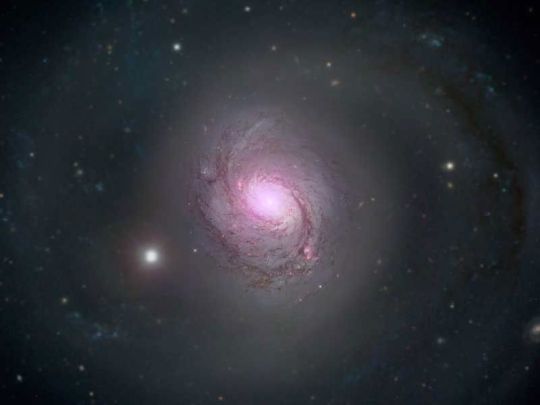
Galaxy NGC 1068 is shown in visible light and X-rays in this composite image. High-energy X-rays (magenta) captured by NASA's Nuclear Spectroscopic Telescope Array, or NuSTAR, are overlaid on visible-light images from both NASA's Hubble Space Telescope and the Sloan Digital Sky Survey. The X-ray light is coming from an active supermassive black hole, also known as a quasar, in the center of the galaxy. This supermassive black hole has been extensively studied due to its relatively close proximity to our galaxy. Source: NASA/JPL-Caltech/Roma Tre Univ.
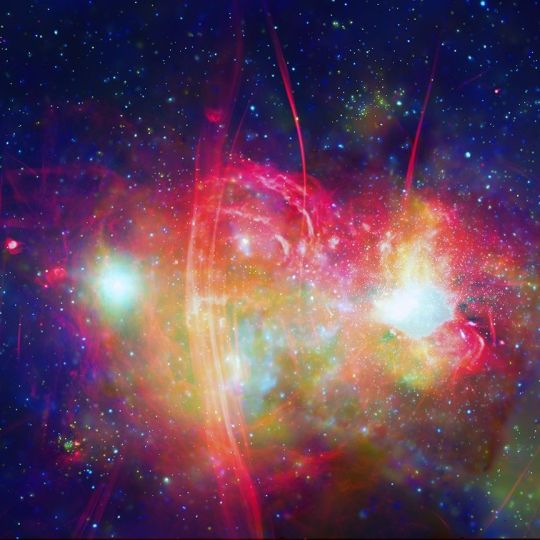
The central region of our galaxy, the Milky Way, contains an exotic collection of objects, including a supermassive black hole, called Sagittarius A*, weighing about 4 million times the mass of the Sun, clouds of gas at temperatures of millions of degrees, neutron stars and white dwarf stars tearing material from companion stars and beautiful tendrils of radio emission. The region around Sagittarius A* is shown in this composite image with Chandra data (green and blue) combined with radio data (red) from the MeerKAT telescope in South Africa, which will eventually become part of the Square Kilometer Array (SKA). Source: X-Ray: NASA/CXC/UMass/D. Wang et al.; Radio: SARAO/MeerKAT.
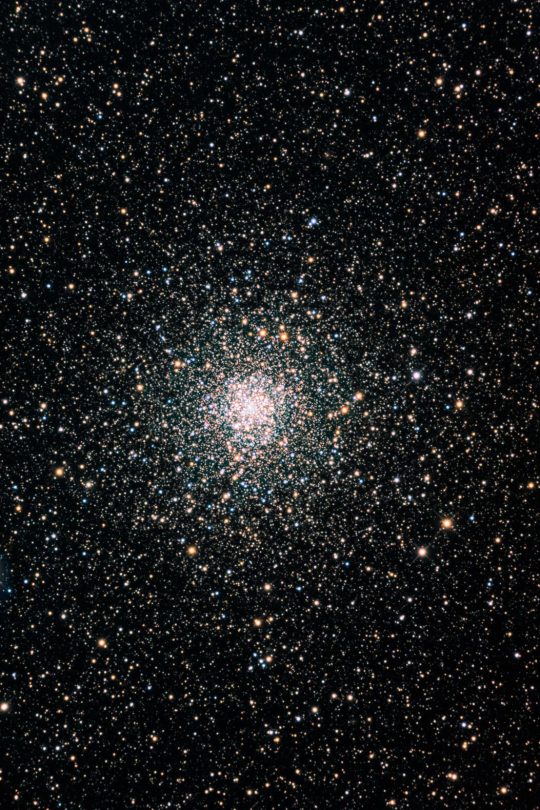
Ground-based Image of Globular Cluster NGC 6397. Credit: D. Verschatse (Antilhue Observatory, Chile).
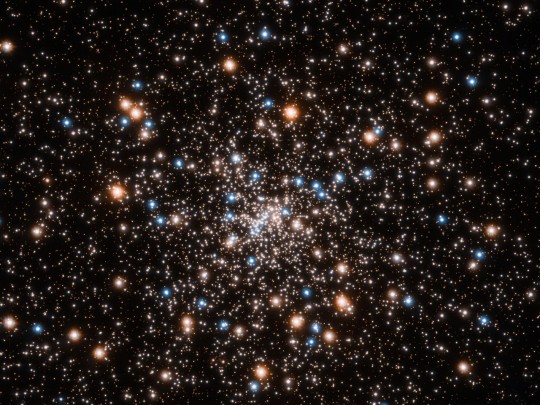
This ancient stellar jewelry box, a globular cluster called NGC 6397, glitters with the light from hundreds of thousands of stars. Astronomers used the NASA/ESA Hubble Space Telescope to gauge the cluster’s distance at 7800 light-years away. NGC 6397 is one of the closest globular clusters to Earth. The cluster’s blue stars are near the end of their lives. These stars have used up their hydrogen fuel that makes them shine. Now they are converting helium to energy in their cores, which fuses at a higher temperature and appears blue. The reddish glow is from red giant stars that have consumed their hydrogen fuel and have expanded in size. The myriad of small white objects include stars like our Sun. This image is composed of a series of observations taken from July 2004 to June 2005 with Hubble’s Advanced Camera for Surveys. The research team used Hubble’s Wide Field Camera 3 to measure the distance to the cluster. Credit: NASA, ESA, and T. Brown and S. Casertano (STScI), Acknowledgement: NASA, ESA, and J. Anderson (STScI).
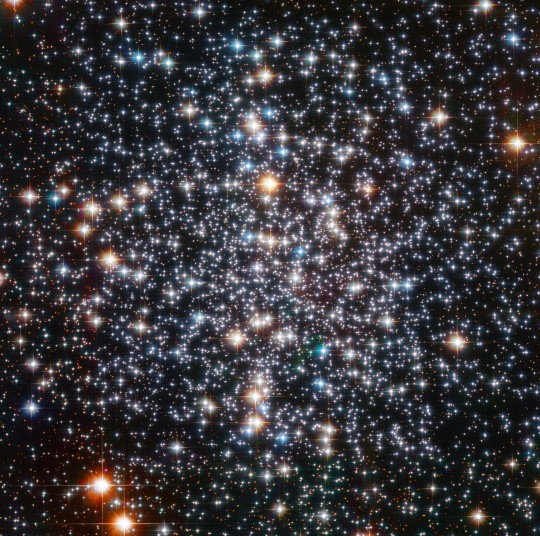
A Hubble Space Telescope image of the globular star cluster, Messier 4. The cluster is a dense collection of several hundred thousand stars. Astronomers suspect that an intermediate-mass black hole, weighing as much as 800 times the mass of our Sun, is lurking, unseen, at its core. Credit: ESA/Hubble, NASA, Eduardo Vitral (STScI).
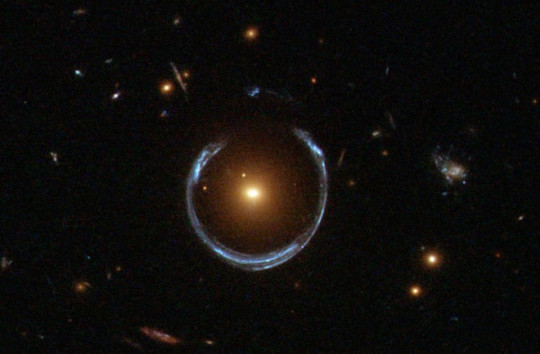
A phenomenon known as an "Einstein Ring" created when light is bent by gravity around a large object. In this case, the large red galaxy in the middle is causing light from a much more distant blue galaxy directly behind it to be bent around into the shape of a ring. Source: ESA/Hubble/NASA.
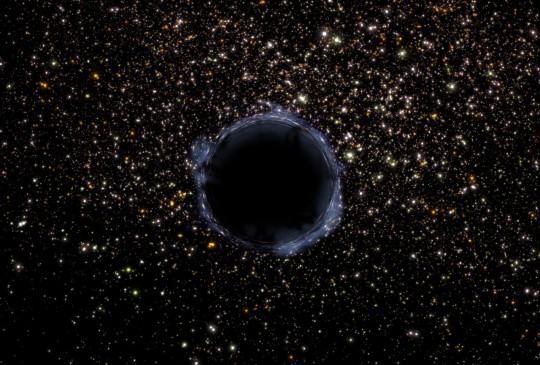
Hubble discovers Black Holes in unexpected places. Source: NASA/ESA and G. Bacon (STScI).

Scientists discovered a concentration of small black holes in the center of the globular cluster NGC 6397. Source: ESA/Hubble.
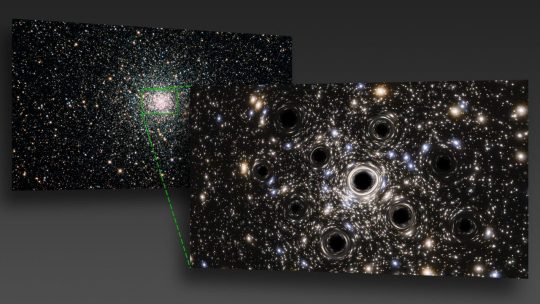
Scientists were expecting to find an intermediate-mass black hole at the heart of the globular cluster NGC 6397, but instead, they found evidence of a concentration of smaller black holes lurking there. New data from the NASA/ESA Hubble Space Telescope have led to the first measurement of the extent of a collection of black holes in a core-collapsed globular cluster. Credit: ESA/Hubble, N. Bartmann.
1 note
·
View note
Text
Black Holes – Energy Beam

An illustration of a distant quasar; powered by feeding black holes, quasars are some of the most luminous objects in the universe. Credit: ESO/M. Kornmesser.

Artist’s impression depicting a wind flowing from around a supermassive black hole at the center of a bright spiral galaxy. Source: European Space Agency (ESA).

In 2015, researchers discovered a black hole named CID-947 that grew much more quickly than its host galaxy. The black hole at the galaxy’s center is nearly 7 billion times the mass of our Sun, placing it among the most massive black holes discovered. The galaxy’s mass, however, is considered normal. Because its light had to travel a very long distance, scientists were observing it at a period when the universe was less than 2 billion years old, just 14% of its current age (almost 14 billion years have passed since the Big Bang). Source: M. Helfenbein, Yale University / OPAC.

This artist's concept shows the most distant supermassive black hole ever discovered. It is part of a quasar from just 690 million years after the Big Bang. Source: Robin Dienel/Carnegie Institution for Science.

Massive black hole eruption illustration. Source: European Space Agency (ESA).

Illustration of a quasar in the early universe. Researchers will study the galaxies that surround three bright quasars in detail for the first time with the James Webb Space Telescope. Credit: NASA, ESA, CSA, Joseph Olmsted (STScI).

This artist concept illustrates a supermassive black hole with millions to billions times the mass of our Sun. Supermassive black holes are enormously dense objects buried at the hearts of galaxies. Source: NASA/JPL-Caltech.

This animation illustrates the activity surrounding a black hole. While the matter that has passed the black hole's event horizon can't be seen, material swirling outside this threshold is accelerated to millions of degrees and radiates in X-rays. Source: CXC/A.Hobart.

A black hole. Credit: NASA.
0 notes
Text
Two-Storey Houses - 3D Style

Source: Bing/Pinterest.
0 notes
Text
Two-Storey Houses - Anime Style

Source: Ngọc Ánh/Pinterest.

Source: ESTHER ROULLETTE/Pinterest.

Source: Pinterest.

Source: ESTHER ROULLETTE/Pinterest.

Source: Freepik.

Source: Freepik.

Solarpunk House. Source: solarpunk-art/RedBubble.
0 notes
Text
Coffee Shops - Retro Anime Style

Cozy Retro Anime Coffee Shop. Source: Edward Tran/Pinterest.

Cozy Retro Anime Coffee Shop. Source: Edward Tran/Pinterest.

Source: Татьяна Анатольевна/Pinterest.

Source: Pinterest.
0 notes
Text
Kitchens - Anime Style

Source: Freepik.

Source: Freepik.

Source: Freepik.

Source: Atalanya/Pinterest.
0 notes
Text
Coffee Shops - 3D Style

Cafe. Source: Franfrogy/Devianart.

Wooden Coffee Shop. Source: Anime Landscape.
0 notes
Text
Coffee Shops – 3D Vector Style

Source: Freepik.

Source: Freepik.

Source: Freepik.

Source: Freepik.

Source: Freepik.
0 notes
Text
Coffee Shops - Anime Style

Source: stablecog.com.

Source: Freepik.

Source: Abby/Pinterest.

The Garden Cafe. Source: heinikafa/Freepik.

Source: Freepik.

Lens & Latte Cafe. Source: stablediffusionweb.com.

Beer Paw Coffee Cafe. Source: NightCafe Studio.

Source: Freepik.

Source: Free Vectors.

Source: Marrens Eve/Pinterest.

Anime Cafè Art. Source: Moe/Pinterest.

Source: DarkAzurite/Pinterest.

Source: AishSri/Pinterest.

Source: AishSri/Pinterest.

Source: AishSri/Pinterest.
1 note
·
View note